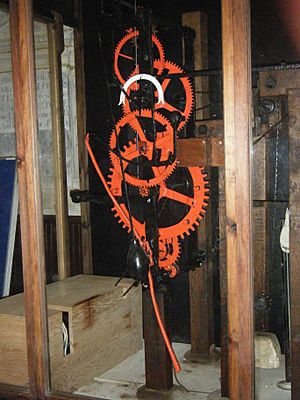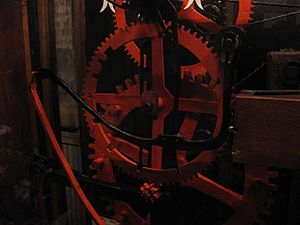Castle Combe Clock facts for kids
The Castle Combe clock is a very old clock found in St. Andrew's Church in Castle Combe, Wiltshire, England. It was likely built in the late 1400s. This special clock doesn't have a face or hands. Instead, it rings a bell in the church tower to tell the time.
Contents
History of the Clock
We don't know the exact date the Castle Combe clock was built. But it looks a lot like other old clocks, like the one at Exeter Cathedral Clock or the Cotehele clock. Because of this, experts think it was made in the late 1400s.
Around 1670, the clock was changed. It originally used an older system called a "verge and foliot." This was updated to use a pendulum, which made it more accurate. To do this, the clock was actually turned upside down! Its parts for striking the hour bell were also changed to fit the new setup.
In 1984, the clock was moved. It came down from the bell tower and was placed in the main part of the church. It now sits on a concrete base inside a wooden cabinet with glass sides. During this move, some parts were painted bright orange. A minute hand and a small dial were added, even though the clock doesn't have a full face. The old hand-winding parts were removed, and electric motors were put in to wind the clock.
How the Clock Works
The Castle Combe clock has two main parts. The "going train" keeps the time, and the "striking train" rings the bell. Before it was changed to use a pendulum, these parts were arranged the other way around.
The Clock's Frame
The clock's main frame is made from strong wrought iron. It has two vertical bars and two horizontal bars. These bars are held together very securely with wedges. The frame pieces are about 1 centimeter thick and 3 centimeters wide.
The Going Train
The going train is the part that keeps the clock ticking. It has an "anchor escapement," which is a special part that helps control the pendulum's swing. We don't know when this part was added.
The pendulum swings once every second. The escapement wheel, which is made of brass, has 20 teeth. This means the main shaft of the escapement turns completely every 40 seconds.
The going train has several gears that work together. One large wheel is likely the only original gear from when the clock was first built. It looks the same as the gears in the striking train. A minute hand and dial were probably added after 1971, as they don't appear in older photos of the clock.
The Striking Train
The striking train is what makes the clock ring the bell. It has a big wheel with 48 teeth. These teeth are shaped like rectangles with rounded tops.
Below this big wheel, there's another shaft with gears. This shaft has a balanced metal rod attached to it. This rod helps the clock know when to strike and when to stop.
There's also a "fly" at the back of the clock. This part spins quickly to control the speed of the striking mechanism. When the clock strikes, the fly turns 18 times for each full turn of the main wheel.
Above the big wheel, there's a "count wheel" on the front of the clock. This wheel has 78 teeth on its outer edge and 12 notches on the inside. The count wheel helps the clock know how many times to strike the bell for each hour. For example, at 3 o'clock, it strikes three times. The count wheel makes sure the correct number of strikes happens.
Most of the parts in the striking train seem to be original. However, the count wheel might have been replaced later. It's possible that the very first count wheel only rang the bell once every hour, which was common for clocks like this.
Locking and Releasing the Strike
When the clock was turned upside down for the pendulum conversion, the way it locked and released the strike had to be changed. Now, gravity helps the locking mechanism work.
Near the count wheel, there's a three-pronged fork-like part. This fork helps hold a part called the "flail" in place. It also helps release the striking mechanism.
On the main shaft of the going train, there are two metal pegs. These pegs turn once every hour. The first, shorter peg pushes the fork up a little. This releases the flail and moves a lock pin out of the count wheel. This is like a "warning" that the clock is about to strike. A few minutes later, the second, longer peg fully releases the flail. The flail then turns, and the clock strikes the hour. Once the correct number of strikes is done, the fork dips back down, and its left prong stops the flail until the next hour.
Bell Lever
A lever is connected to the main striking shaft. As the hour pins on the big wheel move up, they push this lever. The lever is connected by a steel wire to the bell in the church tower. This is how the clock makes the bell ring!



